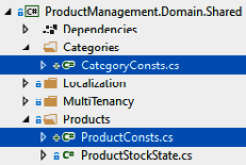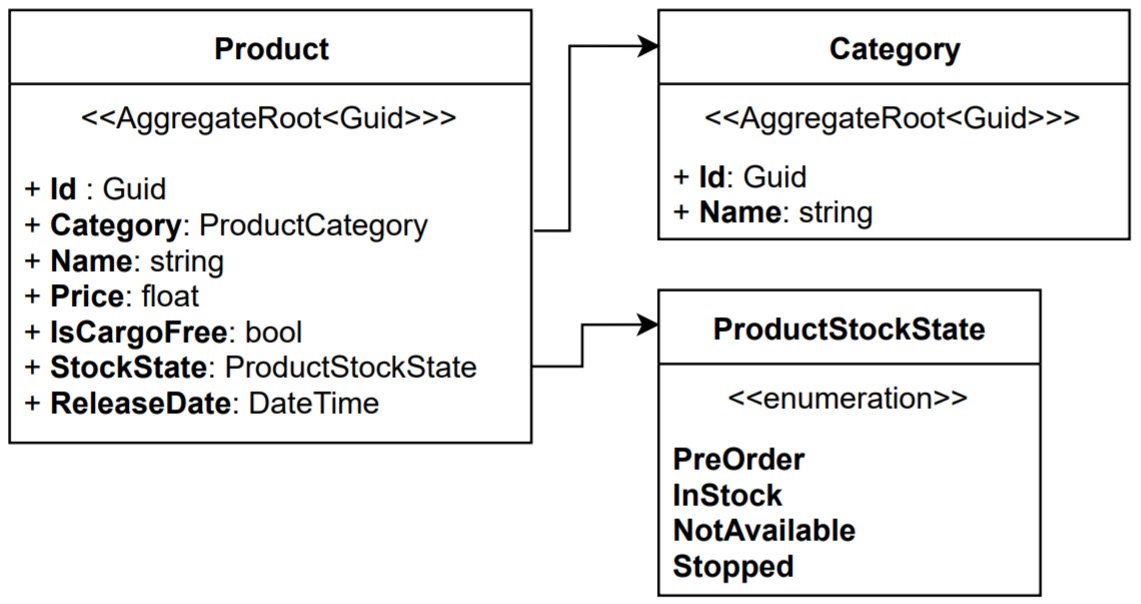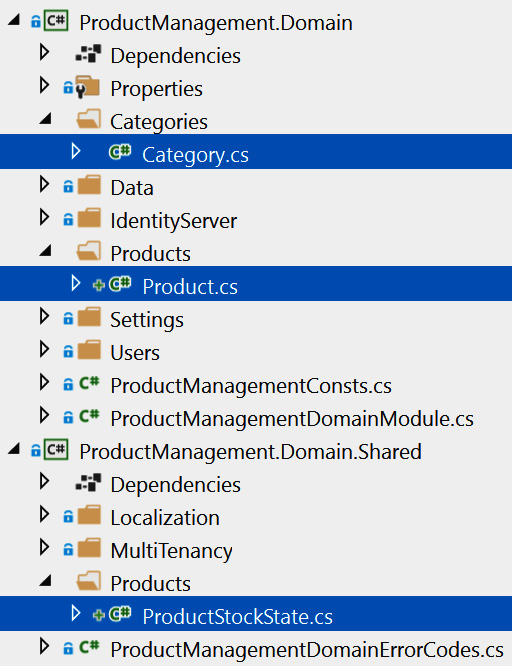ABP应用开发(Step by Step)-上篇
本文主要通过逐步构建一个CRUD示例程序来介绍 ABP 框架的基础知识。它涉及到应用开发的多个方面。在本章结束时,您将了解ABP 框架的基本开发方式。建议入门人员学习,老手不要浪费您宝贵时间。
创建解决方案


现在,领域层已经完成定义,接下来将为 EF Core 配置数据库映射。

如果你得到一个诸如No DbContext was found in assembly... 之类的错误,请确保您已将*.EntityFrameworkCore*项目设置为默认项目。
第1步是为产品管理解决方案(如果您在前面已经创建过了ProductManagement解决方案,可以继续使用它)。在这里,我们运行以下ABP CLI 来进行创建:
abp new ProductManagement -t app
我们使用自己熟悉的 IDE 中打开解决方案,创建数据库,然后运行 Web 项目。如果您在运行解决方案时遇到问题,请参阅上一章,或者在知识星球里留言。
现在我们有一个正在可运行的解决方案。下一步创建领域对象来正式启动编码。
定义领域对象
该应用的领域很简单,有Product和Category两个实体以及一个ProductStockState枚举,如图所示:

实体在解决方案的领域层中定义,它分为两个项目:

实体在解决方案的领域层中定义,它分为两个项目:
-
.Domain用于定义您的实体、值对象、领域服务、存储库接口和其他与领域相关的核心类。
-
.Domain.Shared用于定义一些可用于其他层的共享类型。通常,我们在这里定义枚举和一些常量。
产品类别实体(Category)
Category实体用于对产品进行分类。在ProductManagement.Domain项目中创建一个Categories文件夹,并在其中创建一个Category类:using System; using Volo.Abp.Domain.Entities.Auditing; namespace ProductManagement.Categories { public class Category : AuditedAggregateRoot<Guid> { public string Name { get; set; } } }
Category类派生自AuditedAggregateRoot<Guid>,这里Guid是实体的主键 (Id) 。您可以使用任何类型的主键(例如int、long或string)。AggregateRoot是一种特殊的实体,用于创建聚合的根实体。它是一个领域驱动设计(DDD) 概念,我们将在接下来的章节中更详细地讨论。相比
AggregateRoot类,AuditedAggregateRoot添加了更多属性:CreationTime、CreatorId、LastModificationTime和LastModifierId。当您将实体插入数据库时,ABP 会自动给这些属性赋值,
CreationTime会设置为当前时间,CreatorId会自动设置为当前用户的Id属性。关于充血领域模型
在本章中,我们使用公共的 getter 和 setter 来保持实体的简单性。如果您想创建更丰富的领域模型并应用 DDD 原则和其他最佳实践,我们将在后面的文章中讨论它们。
在本章中,我们使用公共的 getter 和 setter 来保持实体的简单性。如果您想创建更丰富的领域模型并应用 DDD 原则和其他最佳实践,我们将在后面的文章中讨论它们。
产品库存状态枚举(ProductStockState)
ProductStockState是一个简单的枚举,用来设置和跟踪产品库存。我们在*.Domain.Shared项目中创建一个Products*文件夹和一个枚举
ProductStockState:namespace ProductManagement.Products { public enum ProductStockState : byte { PreOrder, InStock, NotAvailable, Stopped } }
我们将在数据传输对象(DTO) 和界面层复用该枚举。
产品实体(Product)
在.Domain项目中创建一个Products文件夹,并在其中创建一个类
Product:using System; using Volo.Abp.Domain.Entities.Auditing; using ProductManagement.Categories; namespace ProductManagement.Products { public class Product : FullAuditedAggregateRoot<Guid> { public Category Category { get; set; } public Guid CategoryId { get; set; } public string Name { get; set; } public float Price { get; set; } public bool IsFreeCargo { get; set; } public DateTime ReleaseDate { get; set; } public ProductStockState StockState { get; set; } } }
这一次,我继承自FullAuditedAggregateRoot,相比Categoryd的AuditedAggregateRoot类,它还增加了IsDeleted、DeletionTime和DeleterId属性。
FullAuditedAggregateRoot实现了ISoftDelete接口,用于实体的软删除。即它永远不会从数据库中做物理删除,而只是标记为已删除。ABP 会自动处理所有的软删除逻辑。包括下次查询时,已删除的实体会被自动过滤,除非您有意请求它们,否则它不会在查询结果中显示。导航属性
在这个例子中,
Product.Category是一个导航属性为Category的实体。如果您使用 MongoDB 或想要真正实现 DDD,则不应将导航属性添加到其他聚合中。但是,对于关系数据库,它可以完美运行并为我们的代码提供灵活性。解决方案中的新文件如图所示:

我们已经创建了领域对象。接下来是常量值。

我们已经创建了领域对象。接下来是常量值。
常量值
这些常量将在输入验证和数据库映射阶段进行使用。
首先,在.Domain.Shared项目中创建一个 Categories 文件夹并在里面添加一个类
CategoryConsts:namespace ProductManagement.Categories { public static class CategoryConsts { public const int MaxNameLength = 128; } }
在这里,
MaxNameLength值将用于Category的Name属性的约束。然后,在.Domain.Shard的 Products 文件夹中创建一个
ProductConsts类:namespace ProductManagement.Products { public static class ProductConsts { public const int MaxNameLength = 128; } }
该
MaxNameLength值将用于约束Product的Name属性。

现在,领域层已经完成定义,接下来将为 EF Core 配置数据库映射。
EF Core和数据库映射
我们在该应用中使用EF Core。EF Core 是一个由微软提供的对象关系映射(ORM) 提供程序。ORM 提供了抽象,让您感觉像是在使用代码实体对象而不是数据库表。我们将在后面的使用数据访问基础架构中介绍 ABP 的 EF Core 集成。现在,我们先了解如何使用它。
-
首先,我们将实体添加到
DbContext类并定义实体和数据库表之间的映射; -
然后,我们将使用 EF Core 的Code First方法创建对应的数据库表;
-
接下来,我们再看 ABP 的种子数据系统,并插入一些初始数据;
-
最后,我们会将数据库表结构和种子数据迁移到数据库中,以便为应用程序做好准备。
让我们从定义
DbSet实体的属性开始。将实体添加到 DbContext 类
EF的
DbContext有两个主要用途:-
定义实体和数据库表之间映射;
-
访问数据库和执行数据库相关实体的操作。
在.EntityFrameworkCore项目中打开
ProductManagementDbContext该类,添加以下属性:public DbSet<Product> Products { get; set; } public DbSet<Category> Categories { get; set; }
EF Core 可以使用基于属性名称和类型的约定进行大部分映射。如果要自定义默认的映射配置或额外的配置,有两种方法:数据注释(属性)和Fluent API。
在数据注释方法中,我们向实体属性添加特性,例如
与Fluent API相比,数据注释容易受限,比如,当你需要使用EF Core的自定义特性时,他会让你的领域层依赖EF Core的NuGet包,比如
[Required]和[StringLength],非常方便,也很容易理解。与Fluent API相比,数据注释容易受限,比如,当你需要使用EF Core的自定义特性时,他会让你的领域层依赖EF Core的NuGet包,比如
[Index]和[Owned]在本章中,我更倾向 Fluent API 方法,它使实体更干净,并将所有 ORM 逻辑放在基础设施层中。
将实体映射到数据库表
类
ProductManagementDbContext(在*.EntityFrameworkCore*项目中)包含一个OnModelCreating方法用来配置实体到数据库表的映射。当你首先创建您的解决方案时,此方法看起来如下所示:protected override void OnModelCreating(ModelBuilder builder) { base.OnModelCreating(builder); builder.ConfigurePermissionManagement(); builder.ConfigureSettingManagement(); builder.ConfigureIdentity(); ...configuration of the other modules /* Configure your own tables/entities here */ }
再添加Category和Product实体的配置和映射关系:
builder.Entity<Category>(b => { b.ToTable("Categories"); b.Property(x => x.Name) .HasMaxLength(CategoryConsts.MaxNameLength) .IsRequired(); b.HasIndex(x => x.Name); }); builder.Entity<Product>(b => { b.ToTable("Products"); b.Property(x => x.Name) .HasMaxLength(ProductConsts.MaxNameLength) .IsRequired(); b.HasOne(x => x.Category) .WithMany() .HasForeignKey(x => x.CategoryId) .OnDelete(DeleteBehavior.Restrict) .IsRequired(); b.HasIndex(x => x.Name).IsUnique(); });
我们使用CategoryConsts.MaxNameLength设置表Category的Name字段的最大长度。Name字段也是必填属性。最后,我们为属性定义了一个唯一的数据库索引,因为它有助于按Name字段搜索。
Product映射类似于Category。此外,它还定义了Category实体与Product实体之间的关系;一个Product实体属于一个Category实体,而一个Category实体可以有多个Product实体。您可以参考 EF Core 官方文档进一步了解 Fluent API 的所有详细信息和其他选项。
映射配置完成后,我们就可以创建数据库迁移,把我们新加的实体转换成数据库结构。
映射配置完成后,我们就可以创建数据库迁移,把我们新加的实体转换成数据库结构。
添加迁移命令
当你创建一个新的实体或对现有实体进行更改,还应该同步到数据库中。EF Core 的Code First就是用来同步数据库和实体结构的强大工具。通常,我们需要先生成迁移脚本,然后执行迁移命令。迁移会对数据库的架构进行增量更改。有两种方法可以生成新迁移:
1 使用 Visual Studio
如果你正在使用Visual Studio,请打开视图|包管理器控制台菜单:


选择.EntityFrameworkCore项目作为默认项目,并右键设置.Web项目作为启动项目
现在,您可以在 控制台中键入以下命令:
1 | Add-Migration "Added_Categories_And_Products" |
此命令的输出应类似于:

如果你得到一个诸如No DbContext was found in assembly... 之类的错误,请确保您已将*.EntityFrameworkCore*项目设置为默认项目。
如果一切顺利,会在.EntityFrameworkCore项目的Migrations文件夹中添加一个新的迁移类。
2 在命令行中
如果您不使用Visual Studio,你可以使用 EF Core命令行工具。如果尚未安装,请在命令行终端中执行以下命令:
dotnet tool install --global dotnet-ef
现在,在.EntityFrameworkCore项目的根目录中打开一个命令行终端,然后输入以下命令:
1 | dotnet ef migrations add "Added_Categories_And_Products" |
一个新的迁移类会添加到.EntityFrameworkCore项目的Migrations文件夹中。
种子数据
种子数据系统用于迁移数据库时添加一些初始数据。例如,身份模块在数据库中创建一个管理员用户,该用户具有登录应用程序的所有权限。
虽然种子数据在我们的场景中不是必需的,这里我想将一些产品类别和产品的初始化数据添加到数据库中,以便更轻松地开发和测试应用程序。
关于 EF Core 种子数据
本节使用 ABP 的种子数据系统,而 EF Core 有自己的种子数据功能。ABP 种子数据系统允许您在代码中注入运行时服务并实现高级逻辑,适用于开发、测试和生产环境。但是,对于简单的开发和测试,使用 EF Core 的种子数据基本够用。请查看官方文档。
在ProductManagement.Domain项目的Data文件夹中创建一个
ProductManagementDataSeedContributor类:using ProductManagement.Categories; using ProductManagement.Products; using System; using System.Threading.Tasks; using Volo.Abp.Data; using Volo.Abp.DependencyInjection; using Volo.Abp.Domain.Repositories; namespace ProductManagement.Data { public class ProductManagementDataSeedContributor : IDataSeedContributor, ITransientDependency { private readonly IRepository<Category, Guid>_categoryRepository; private readonly IRepository<Product, Guid>_productRepository; public ProductManagementDataSeedContributor( IRepository<Category, Guid> categoryRepository, IRepository<Product, Guid> productRepository) { _categoryRepository = categoryRepository; _productRepository = productRepository; } public async Task SeedAsync(DataSeedContext context) { /***** TODO: Seed initial data here *****/ } } }
该类实现了IDataSeedContributor接口,ABP 会自动发现并调用其SeedAsync方法。您也可以实现构造函数注入并使用类中的任何服务(例如本示例中的存储库)。
然后,在
SeedAsync方法内部编码:if (await _categoryRepository.CountAsync() > 0) { return; } var monitors = new Category { Name = "Monitors" }; var printers = new Category { Name = "Printers" }; await _categoryRepository.InsertManyAsync(new[] { monitors, printers }); var monitor1 = new Product { Category = monitors, Name = "XP VH240a 23.8-Inch Full HD 1080p IPS LED Monitor", Price = 163, ReleaseDate = new DateTime(2019, 05, 24), StockState = ProductStockState.InStock }; var monitor2 = new Product { Category = monitors, Name = "Clips 328E1CA 32-Inch Curved Monitor, 4K UHD", Price = 349, IsFreeCargo = true, ReleaseDate = new DateTime(2022, 02, 01), StockState = ProductStockState.PreOrder }; var printer1 = new Product { Category = monitors, Name = "Acme Monochrome Laser Printer, Compact All-In One", Price = 199, ReleaseDate = new DateTime(2020, 11, 16), StockState = ProductStockState.NotAvailable }; await _productRepository.InsertManyAsync(new[] { monitor1, monitor2, printer1 });
我们创建了两个类别和三种产品并将它们插入到数据库中。每次您运行DbMigrator应用时都会执行此类。同时,我们检查if (await _categoryRepository.CountAsync() > 0)以防止数据重复插入。
种子数据和数据库表结构准备就绪, 下面进入正式迁移。
迁移数据库
EF Core 和 ABP 的迁移有何区别?
ABP 启动模板中包含一个在开发和生产环境中非常有用的DbMigrator控制台项目。当您运行它时,所有待处理的迁移都将应用到数据库中,并执行数据初始化。
它支持多租户/多数据库的场景,这是使用
它支持多租户/多数据库的场景,这是使用
Update-Database无法实现的。为什么要从主应用中分离出迁移项目?
在生产环境中部署和执行时,通常作为持续部署(CD) 管道的一个环节。从主应用中分离出迁移功能有个好处,主应用不需要更改数据库的权限。此外,如果不做分离可能会遇到数据库迁移和执行的并发问题。
将.DbMigrator项目设置为启动项目,然后按 Ctrl+F5 运行该项目,待应用程序退出后,您可以检查Categories和Products表是否已插入数据库中(如果您使用 Visual Studio,则可以使用SQL Server 对象资源管理器连接到LocalDB并浏览数据库)。
数据库已准备好了。接下来我们将在 UI 上显示产品数据。
定义应用服务
思路
我更倾向逐个功能地推进应用开发。本文将说明如何在 UI 上显示产品列表。
-
首先,我们会为
Product实体定义一个ProductDto; -
然后,我们将创建一个向表示层返回产品列表的应用服务方法;
-
此外,我们将学习如何自动映射
Product到ProductDto
在创建 UI 之前,我将向您展示如何为应用服务编写自动化测试。这样,在开始 UI 开发之前,我们就可以确定应用服务是否正常工作。
在整个在开发过程中,我们将探索 ABP 框架的一些能力,例如自动 API 控制器和动态 JavaScript 代理系统。
最后,我们将创建一个新页面,并在其中添加一个数据表,然后从服务端获取产品列表,并将其显示在 UI 上。
梳理完思路,我们从创建一个
ProductDto类开始。ProductDto 类
DTO 用于在应用层和表示层之间传输数据。最佳实践是将 DTO 返回到表示层而不是实体,因为将实体直接暴露给表示层可能导致序列化和安全问题,有了DTO,我们不但可以抽象实体,对接口展示内容也更加可控。
为了在 UI 层中可复用,DTO 规定在Application.Contracts项目中进行定义。我们首先在*.Application.Contracts项目的Products文件夹中创建一个
ProductDto类:using System; using Volo.Abp.Application.Dtos; namespace ProductManagement.Products { public class ProductDto : AuditedEntityDto<Guid> { public Guid CategoryId { get; set; } public string CategoryName { get; set; } public string Name { get; set; } public float Price { get; set; } public bool IsFreeCargo { get; set; } public DateTime ReleaseDate { get; set; } public ProductStockState StockState { get; set; } } }
ProductDto与实体类基本相似,但又有以下区别:-
它派生自
AuditedEntityDto<Guid>,它定义了Id、CreationTime、CreatorId、LastModificationTime和LastModifierId属性(我们不需要做删除审计DeletionTime,因为删除的实体不是从数据库中读取的)。 -
我们没有向实体
Category添加导航属性,而是使用了一个string类型的CategoryName的属性,用以在 UI 上显示。
我们将使用使用
ProductDto类从IProductAppService接口返回产品列表。产品应用服务
应用服务实现了应用的业务逻辑,UI 调用它们用于用户交互。通常,应用服务方法返回一个 DTO。
1 应用服务与 API 控制器
ABP的应用服务和MVC 中的 API 控制器有何区别?
您可以将应用服务与 ASP.NET Core MVC 中的 API 控制器进行比较。虽然它们有相似之处,但是:
-
应用服务更适合 DDD ,它们不依赖于特定的 UI 技术。
-
此外,ABP 可以自动将您的应用服务公开为 HTTP API。
我们在*.Application.Contracts项目的Products文件夹中创建一个
IProductAppService接口:using System.Threading.Tasks; using Volo.Abp.Application.Dtos; using Volo.Abp.Application.Services; namespace ProductManagement.Products { public interface IProductAppService : IApplicationService { Task<PagedResultDto<ProductDto>> GetListAsync(PagedAndSortedResultRequestDto input); } }
我们可以看到一些预定义的 ABP 类型:
-
IProductAppService约定从IApplicationService接口,这样ABP 就可以识别应用服务。 -
GetListAsync方法的入参PagedAndSortedResultRequestDto是 ABP 框架的标准 DTO 类,它定义了MaxResultCount、SkipCount和Sorting属性。 -
GetListAsync方法返回PagedResultDto<ProductDto>,其中包含一个TotalCount属性和一个ProductDto对象集合,这是使用 ABP 框架返回分页结果的便捷方式。
当然,您可以使用自己的 DTO 代替这些预定义的 DTO。但是,当您想要标准化一些常见问题,避免到处都使用相同的命名时,它们非常有用。
2 异步方法
将所有应用服务方法定义为异步方法是最佳实践。如果您定义为同步方法,在某些情况下,某些 ABP 功能(例如工作单元)可能无法按预期工作。
现在,我们可以实现
IProductAppService接口来执行用例。3 产品应用服务
我们在ProductManagement.Application项目中创建一个
ProductAppService类:using System.Linq.Dynamic.Core; using System.Threading.Tasks; using Volo.Abp.Application.Dtos; using Volo.Abp.Domain.Repositories; namespace ProductManagement.Products { public class ProductAppService : ProductManagementAppService, IProductAppService { private readonly IRepository<Product, Guid> _productRepository; public ProductAppService(IRepository<Product, Guid> productRepository) { _productRepository = productRepository; } public async Task<PagedResultDto<ProductDto>> GetListAsync(PagedAndSortedResultRequestDto input) { /* TODO: Implementation */ } } }
ProductAppService派生自ProductManagementAppService,它在启动模板中定义,可用作应用服务的基类。它实现了之前定义的IProductAppService接口,并注入IRepository<Product, Guid>服务。这就是通用默认存储库,方面我们对数据库执行操作(ABP 自动为所有聚合根实体提供默认存储库实现)。我们实现
GetListAsync方法,如下代码块所示:public async Task<PagedResultDto<ProductDto>> GetListAsync(PagedAndSortedResultRequestDto input) { var queryable = await _productRepository.WithDetailsAsync(x => x.Category); queryable = queryable .Skip(input.SkipCount) .Take(input.MaxResultCount) .OrderBy(input.Sorting ?? nameof(Product.Name)); var products = await AsyncExecuter.ToListAsync(queryable); var count = await _productRepository.GetCountAsync(); return new PagedResultDto<ProductDto>( count, ObjectMapper.Map<List<Product>, List<ProductDto>>(products) ); }
这里,
_productRepository.WithDetailsAsync返回一个包含产品类别的IQueryable<Product>对象,(WithDetailsAsync方法类似于 EF Core 的Include扩展方法,用于将相关数据加载到查询中)。于是,我们就可以方便地使用标准的(LINQ) 扩展方法,比如Skip、Take和OrderBy等。AsyncExecuter服务(基类中预先注入)用于执行IQueryable对象,这使得可以使用异步 LINQ 扩展方法执行数据库查询,而无需依赖应用程序层中的 EF Core 包。(我们将在[第 6 章 ] 中对AsyncExecuter进行更详细的探讨)最后,我们使用
ObjectMapper服务(在基类中预先注入)将Product集合映射到ProductDto集合。对象映射
ObjectMapper(IObjectMapper)会自动使用AutoMapper库进行类型转换。它要求我们在使用之前预先定义映射关系。启动模板包含一个配置文件类,您可以在其中创建映射。在ProductManage.Application项目中打开
ProductManagementApplicationAutoMapperProfile类,并将其更改为以下内容:using AutoMapper; using ProductManagement.Products; namespace ProductManagement { public class ProductManagementApplicationAutoMapperProfile : Profile { public ProductManagementApplicationAutoMapperProfile() { CreateMap<Product, ProductDto>(); } } }
如
CreateMap所定义的映射。它可以自动将Product转换为ProductDto对象。AutoMapper中有一个有趣的功能:Flattening,它默认会将复杂的对象模型展平为更简单的模型。在这个例子中,
Product类有一个Category属性,而Category类也有一个Name属性。因此,如果要访问产品的类别名称,则应使用Product.Category.Name表达式。但是,ProductDto的CategoryName可以直接使用ProductDto.CategoryName表达式进行访问。AutoMapper 会通过展平Category.Name来自动映射成CategoryName。应用层服务已经基本完成。在开始 UI 之前,我们会先介绍如何为应用层编写自动化测试,敬请期待下文。





